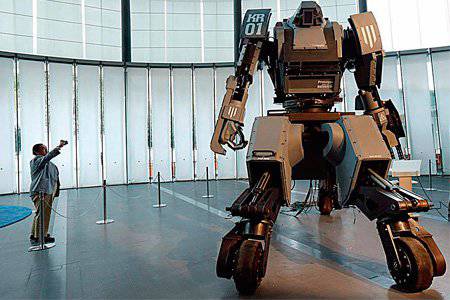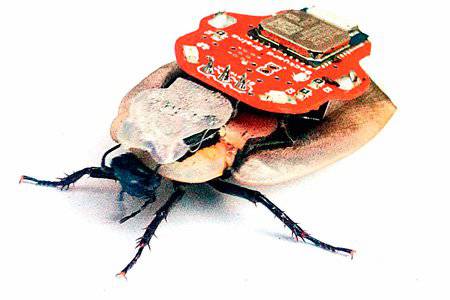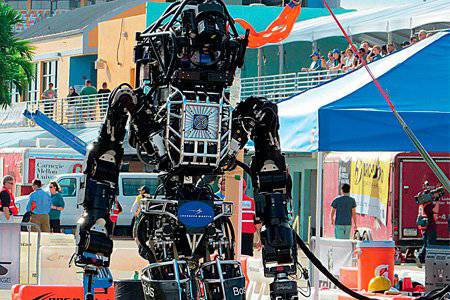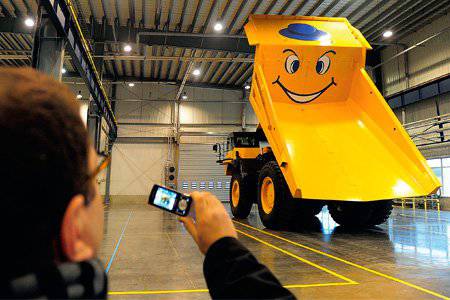On the sidelines of inhuman progress
Most of us associate the word "robot" with humanoid creatures that can clean the house, run to the store for beer, and save the world in their free time from these worries. Or with evil war machines conquering unfortunate humanity. And this is not surprising, because so many myths have not been created about any other technique. Our ideas about robots hailing from science fiction films and books, even the word "robot" itself has a literary origin: it was first used to refer to artificial humanoid creatures by Karel Capek in a play written in 1920.
However, robots have long been fiction. They surround us everywhere: washing machines, sandwich machines, and airliners. We are surprised at the new devices and call them robots when they first enter our life. Over time, they turn into familiar, everyday things.
A distant prototype of an unmanned aerial vehicle, a mechanical pigeon, was created in Ancient Greece in 350 BC. er philosopher and commander Archit Tarentsky. Heron of Alexandria, who lived in Greece in the I century AD. e., made a serious contribution to the mechanics and automation. His work became an innovation in the production of religious wonders: the automatic gates of the temple, a vending machine for the sale of holy water and a device for turning water into wine were designed to increase the profitability of the temple business. The Arabian inventor Al-Jazari made a significant contribution to the development of service robotics; he also created the first programmable androids in the early 13th century. Later, in the XVIII century, they became very popular in Europe.
But robots began to make a serious contribution to the economy only with the development of industrial robotics, which originated in the USA in the 1940s with the advent of painting machines. In 1950, the first patents for robotic arms appeared, and already at the beginning of 1960, the American companies AMF and Unimation released the first of them to the market.
In 2013, the total volume of the industrial robotics market, according to estimates by the International Federation of Robotics (IFR), amounted to 9,5 billion, and taking into account the accompanying software and peripheral devices - more than 29 billion dollars. The main consumers are automotive and electronics manufacturing. This is a mature market with high competition between a small number of large producers and a growth rate of about 8% per year. It has its points of growth: the robotization of medium and small businesses, the creation of robots that can work together with humans. However, the service robotics market has great promise: its volume is 5,3 billion dollars and continues to grow at an impressive pace. The b2b segment in recent years has been growing by more than 30% per year. BUT news from developers seize the opening prospects.
The greatest economic effect should be expected from the robotization of transport, where in the next decade a real revolution can occur. All leading automakers are engaged in the creation of unmanned vehicles. It is known that Nissan, Audi, Volvo, Mercedes, Toyota, Ford, as well as one of the leading manufacturers of automotive components Bosch are already testing their development. From 2015, Tesla Motors promises to equip the Model S electric car with the Autopilot system, which will allow you to drive on highways without driver participation. Our version of the car of the future - “inhuman” Lada Kalina - presented to us. Further advanced Google. Its unmanned vehicles have already covered more than a million kilometers on public roads, without ever having an accident. And in May, the Internet giant presented a working prototype of a two-seater electric vehicle. It does not have the usual controls - just the start button and the display of the navigation system.
Google's interest in the automotive revolution is not limited. In December 2013, he acquired eight different robotics companies at once, and in April 2014, the manufacturer drones Titan Aerospace to provide internet in hard-to-reach areas using solar-powered electric planes hovering around the clock. DHL started using drones to deliver parcels in September. Similar plans are in Amazon, which, in addition, acquired Kiva Systems, which is engaged in warehouse robotization, for $ 775 million in order to prevent its competitors from receiving its developments. Korean engineers have demonstrated a humanoid robot capable of flying an aircraft.
In Western Australia, Rio Tinto has been operating unmanned dump trucks at an iron ore deposit since 2008. These self-propelled giants in the loaded form weigh more than 500 tons, and the center of control over them is located a thousand kilometers from the field.
But transportation is not the only industry where robotization can cause major changes. Robotic cattle-breeding complexes help to increase labor productivity in countries with high labor costs. In 2013, 523 thousand operations were performed with the help of robotic surgeons of only one of the manufacturers - Intuitive Surgical. Asian countries with a rapidly aging population - Japan and South Korea - are actively developing nurse carers and assistants for the elderly and sick people; already used robot teachers.
Suicidal technology
But the main engine of development of robotics remains the key task of mankind - the destruction of their own kind. Automation of this process has long occupied the minds of inventors, but only now we can talk about this technological breakthrough. In 2013, 45% of all sold professional service robots were military. It is INVESTMENT in the technology of murder that make the main contribution to the development of robotics. And ahead of the rest - the United States.
The US military has a special love for mechanical animals and has already financed the creation of a whole robozoo: a cheetah robot, a flea, a cockroach, a mule, a hummingbird, a worm. BigDog became a YouTube star - a pack robot developed by Boston Dynamics for the American army. Desperately shouting with a kerosene engine, the "headless donkey" awkwardly and cautiously goes through the hoofs along the stones. Despite the uncertainty of the step, he is very stable and can stay on his feet even after a powerful kick in the side. Other developments of this company do not cause a smile any more. The relatively humanlike Atlas, an almost two-meter-tall giant weighing 150 kilograms, quite deftly moves on an uneven surface and runs fast. WildCat, a four-legged petrol-powered robot, can reach speeds of 32 km / h - no one will run away from it.
At the universities of the USA and Israel, insect-based cybernetic organisms are being developed by financing the American military. Already managed to install a miniature generator on the beetle, which gives energy to power microelectronics from wing flaps, and implant microscopic fuel cells to the cochlea. The remote control of the movement and flight of insects has been mastered, cyborg cockroaches are made with remote control, carrying directional microphones. These successes fill the term “bugs” with new meaning.
The U.S. Army is already armed with unmanned aircraft, reconnaissance and sapper robots, and are planning to adopt unmanned patrol boats. DARPA, an agency of advanced defense research projects, sponsors the development of unmanned tanks. All of these robotic achievements can be complemented by the latest “smart” ammunition. The US military has already announced self-propelled bullets, and the Tomahawk cruise missile developer Raytheon is testing the latest 155-mm artillery shell, which in addition to GPS navigation has a laser-guided system.
Robotics can seriously change the tactics of wars. Unmanned tanks, managed by divisions of experienced gamers with many years of experience in using the mouse, will be the strike force. Unmanned Aircraft and Precision weapon will allow to destroy the enemy forces, while maintaining valuable infrastructure; swarms of fast-footed robots will drive those who do not want to be forced into the world, and soldiers in exoskeletons, allowing them to carry reinforced armor and powerful weapons, will finally clean up the territory.
Future at public expense
Only in recent years, several trends are laying the foundation for the expected robotic revolution: the growth of computing power and the development of the “Internet of things”, reducing the cost of components, including due to the economies of scale, and the trend towards standardization of platforms in robotics, which will significantly reduce the price of mass products, such as personal computers, medical devices, mobile platforms. And the progress in key technologies will make it possible in the coming years to significantly increase the functionality of robots.
However, while most of the robotic projects are not attractive for private investors. Therefore, the state remains the main source of funding for service robotics. Most actively invest in US military robotics. The first program was launched in 1990 by the Department of Defense, now it is called Defense Ground Robotics Alliance (DGRA). The objectives of the program include coordinating the work of military departments in the field of robotics, formulating priorities for its development, developing standards for specialized software architecture, holding competitions in robotics among students and schoolchildren. The National Advanced Mobility Consortium, an association of universities, laboratories, and companies of the USA, was created on the basis of DGRA in 2008, in the 2013, which financed 65 projects for 70 million dollars. The main directions are system integration and artificial intelligence: machine vision, pattern recognition, speech comprehension, and increased autonomy of actions.

However, the focus on military robotics has led to a lag in civilian, and the primacy of the United States in the development of many technologies does not always provide leadership in their commercial implementation. For example, being the birthplace of industrial robotics, the United States lost its superiority at the end of the 1980s, and later disappeared altogether from the largest manufacturers. In 2011, the problem was recognized at the highest level: the presidential administration prepared a report “On ensuring US leadership in advanced industries,” in which robotics was named one of the 26 lost technological areas. In June 2011, Barack Obama announced the creation of a National Robotics Program focused on civil engineering. Within its framework, the National Science Foundation, NASA, the Ministry of Health and Agriculture got the opportunity each year to send from 30 million to 50 million dollars for basic and applied research. The range of developments is quite wide: from the android robot for manipulating large objects and transporting them to the strawberry harvesting robot.
The European Union finances civilian robotics more actively than the United States. 2007 – 2013 has financed 130 robotic projects involving about 500 organizations and a total amount of grants of 536 million euros. In 2014 – 2015, more than 150 million euros were allocated directly to robotics within the EU Eighth Framework Program for Scientific, Technological and Innovative Development, and funding related areas exceeds 500 million euros. It is managed by SPARC - a public-private partnership between the EU and euRobotics, an association of 180 companies and research organizations.
Serious funding volumes are driven by ambitious goals. EuRobotics plans to create more than one hundred thousand new jobs in manufacturing companies of robots, software and components by 2020 and, due to the growth of this sector of the economy, increase EU GDP by 80 billion euros.
In China, rising labor costs lead to rapid growth in the industrial robotics market — in 2013, it became the largest in the world. The problem of China is the inexperience of manufacturers and the lack of its own high-quality components. Therefore, local manufacturers are still competitive only in the lower price segment. Nevertheless, their growth rates are impressive: foreign companies increased 2013% in 2012 year compared to 20, and local companies tripled, reaching 25-percent market share.
Service robotics in China is not yet among the priorities. Almost all developments are carried out under the state order. So, in the 2013 year, 43 a year after the Soviet, the Chinese lunar rover landed. A two-handed robot is being developed to replace a man at the orbital station, as well as several military robots, including a replica of the famous “headless donkey”. The first Chinese underwater robot, the North Pole, is already conducting subglacial scientific research.
Homeland of fighting robots
Russian robotics has a bright past. It was in the USSR that combat robots were first used. The Soviet TT-26 telecannas were used during the Soviet-Finnish 1939 – 1940 war. Originally intended to use them for spraying chemical weapons and delivering powerful charges to the positions of opponents. In 1964, a supersonic long-range reconnaissance unmanned aerial vehicle DBR-1 (Tu-123) was adopted by the USSR Air Force. In the production of unmanned aerial vehicles, the USSR held leading positions in 1970-1980, in particular, the model Tu-143 was produced around 950 units. In November, the USSR 1970 was the first to land the rover Lunokhod-1 on another celestial body.
The Central Research and Development Institute of Robotics and Technical Cybernetics was established in Leningrad, and in the 1981 year at the MVTU im. N. E. Bauman opened the Robotics Research and Training Center, which developed the most popular industrial robot MP-9С in the USSR, mass-produced from 1982 at the Volga Automobile Plant, the largest consumer and manufacturer of industrial manipulators in the USSR. In 1984, VAZ acquired a license from KUKA for a number of models, which were produced up to 2010, when the batch production of its own developments was launched.
The catastrophe at the Chernobyl nuclear power plant in 1986 led to the need to urgently create special robots for use in harsh radiation conditions dangerous to humans. In the shortest possible time, MVTU developed mobile robotic complexes that could successfully operate in an environment where Japanese and German models were unsuitable.

The current state of the industry is not so brilliant. As one of the main Russian experts in this field succinctly characterized him, “we can only make self-propelled troughs”.
The volume of the domestic market of robotics is negligible. But production does not cover even insignificant Russian demand. The most unpromising development of industrial robotics. High competition in a mature market makes it expedient to only large-scale production, allowing to reduce costs due to scale. But only about 300 industrial robots are sold in Russia annually, whereas, for example, Thailand sold 2012 thousand in 4 in the year. At the same time, the growth potential is small: you should not expect explosive growth in the near future from a key consumer - the automotive industry . The second possible growth engine - electronics - is practically absent in our country. The potential demand for industrial robotics in Russia is also reduced by the low production culture. Automation of individual links in production chains faces the problem of instability in the quality of raw materials and blanks. “At some enterprises, the assembly of products is carried out using scrap and other improvised means, with the result that gaps of the size of a finger are obtained. Even if we apply modern technologies of tracking the weld using laser sensors, the search for a joint will take longer than the welding itself, and the performance of the robotic system will be low. The meaning of automation is lost, because it will be much quicker to weld the parts manually, ”explains Anton Bychkovsky, general director of the engineering company Intellectual Robot Systems.
Entry into foreign markets is difficult: they have long been divided between several of the largest producers, distinguished by the presence of stable ties with key consumers and protectionism against national producers.
The only Russian manufacturer, the Volzhsky Machine-Building Plant, is entering its peak, losing the market. Vladimir Serebrenny, First Deputy General Director of OJSC RT-Stankoinstrument, former General Director of VMZ (2006 – 2012), acknowledges that the result may be the closure of the production of robots at VMZ. It is impossible to make it a highly profitable business due to the extremely unfavorable conditions for production in Russia and the closed nature of foreign markets. When asked why production has survived to the present, Vladimir Serebrenny gives an answer: "The main reason is the enthusiasm and the belief that it is really in demand."
Space robotics is also losing its position. Over the past twenty years, only two interplanetary automatic stations, Mars-96 and Phobos-Grunt, have been launched in Russia. Both failed.
There are not many civilian projects of service robotics in Russia. There are no more than a dozen successful companies, but even their sales volumes are small. Startups are much larger. However, their dynamics do not cause delight. A few success stories, such as the Diakont company, are just exceptions. Obstacles are the lack of commercialization experience, and sometimes motivation of many developers to it, poor marketing and industrial design skills, and geographical distance from the most capacious markets.
Traditional business incubators and accelerators on robotics are stalled. Their bet on enthusiastic youngsters doesn't work. The limited number of ideas for automating life forces those to reinvent the vacuum cleaner. But a dozen developers in Skolkovo with the production of regular vacuum cleaners in China will not save the economy, and the technological breakthrough is unlikely to make. And the costs of entering a more promising market for professional service robotics are high: the high cost of development, the need for expert knowledge of the industry, the difficulty of forming new segments.
Against the background of other areas, special-purpose robotics remains relatively strong, mainly due to Soviet developments of thirty to forty years ago. This is the most protected segment, practically not competing with the equipment of foreign manufacturers, so the demand for it is least dependent on the quality and price of products. However, the gap with the leading countries is already significant. For example, due to the lack of modern unmanned aerial vehicles in 2009, they had to be purchased in Israel. To correct the situation in military robotics, the Advanced Research Foundation, created in October 2012 of the year in imitation of the famous DARPA, makes efforts. However, it is still early to judge the results of its activities.
The transfer of military technology to civilian robotics in all countries is difficult. Although there are vivid examples of success: for example, the American iRobot, which began in 1990 year with the development of the rover, now produces a line of military robots and at the same time has become the world leader in the production of vacuum cleaning robots. But the situation with the transfer in Russia is especially difficult. One of the Russian manufacturers of military robots in response to the proposal to reduce the reservation and the rate of fire of its products and turn them into something useful, such as a lawn mower, angrily replied: "So that I share with these firms?!"
“Ninety percent of the robotics with whom I communicate see only the state as a customer, that is, this or that state structure - the Ministry of Health, the Ministry of Education and Science, the Ministry of Defense,” said Albert Efimov, director of IT projects at the Skolkovo Foundation. “We have government contracts, we don’t really need other money,” the developers answer. “If people have been used to building self-propelled tanks at public expense for decades, they are not able to make a vacuum cleaner in a year and a half at the price of 600 dollars, which should be improved in a few months because it’s outdated,” says Valeria Komissarova, development director of Grishin Robotics.

Photo: Action Press / Tass
A critical problem for all segments of robotics is the lack of domestic components. In particular, it is necessary to purchase abroad especially special bending-resistant cables, as well as bearings, drives, gearboxes, electronic components. In addition, some components are in principle unavailable to Russian manufacturers. “Major German or Japanese manufacturers refuse to supply their products to Russia under the pretext of dual-use components,” said Alexander Batanov, head of the special design and technology bureau of applied robotics at the Moscow State Technical University, even before the introduction of sanctions. N. E. Bauman. The situation is aggravated by the fact that the most important components in terms of product characteristics are made by only one or two companies from developed countries, and this makes it impossible to find an alternative.
A serious obstacle to locating production in Russia is the high level of costs, including tax burden, the cost of loans, electricity, components and labor. This is confirmed by the experience of Rbot, Russia's largest telepresence robot manufacturer. After transferring the production of most parts to their own site in China - Quanzhou Future Robot Technology - the price of robots assembled in Russia was reduced by half.
Finally, almost all market participants talk about the absence of a targeted government policy on robotics. In recent years, the state seems to be beginning to show enthusiasm, but the actions of various departments are not coordinated and ineffective. A striking example is the customs policy: import duties on most components range from 4 to 17,5%, while import duties on final products are absent.
Individual solutions are unlikely to help. Thus, the injection of money only into military robotics will be ineffective: the production of components and the development of technologies for small batches of military equipment will make it prohibitively expensive. In addition, this direction is not self-sufficient, its effective development is possible only in parallel with the civilian, which is the source of technology and personnel. Now educational robotics for schoolchildren and students is actively developing. But keeping the enthusiasm of young people in reserve in the hope that he will ever be in demand is a great way to help the robotics of developed countries, primarily the USA.
Moreover, the development of robotics as a complex derivative of precision engineering, electronics and IT cannot occur in isolation from them. The scale of robotics is incomparable with the complexity of the problems, the solution of which depends on its development, such as precision positioning systems, computer vision technology, artificial intelligence. Therefore, in key technologies, the industry acts only as a dependent consumer.
Not only business incubator
Is it necessary in such adverse conditions to develop domestic robotics? Yes. Already in the medium term, the level of its development will have a significant impact on the defense potential and labor productivity in the main consumer industries.
The eternal desire to be the first is hardly reasonable. In order to become technology leaders, the United States took half a century of thoughtful funding for basic and applied research, pinpoint support to promising companies. Russia has now neither the resources nor the time to repeat this path.
But we have potentially promising areas for the development of our own developments, even if they do not pretend to be unique. First of all, these are segments with substantial domestic demand: military and special robotics, mining, infrastructure maintenance, logistics and healthcare.

Photo: Vladimir Smirnov / Tass
The role of the state will be decisive in the first stage. However, private initiative should play the main role in creating new market niches; small and medium-sized companies are flexible and aimed at aggressive growth. The appearance of a sufficient number of development teams for them cannot be achieved simply by popularizing robotics, organizing competitions and contests, and creating specialized business incubators with the necessary technical base — workshops and test centers. Although all this, of course, is necessary.
The main thing is to select viable projects from this innovative nursery and grow them only in manual mode, feeding state orders, stimulating demand with subsidies, without disdaining administrative resources, declining private companies to orders.
Over time, this painstaking work can lead to the formation of the beginnings of industry clusters and a medium of attraction that is important for the development of robotics. “Generations of start-ups and entrepreneurs are needed, money is needed from exits that will be reinvested in this ecosystem. For example, not in Silicon Valley, but in Boston, around MIT, the second generation of robotic startups, based on those who had previously earned an IPO, is growing. This gives a fundamentally different quality of the environment, ”explains Valeria Komissarov.

Information